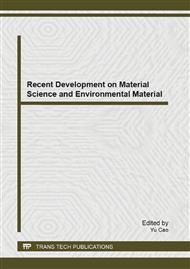p.81
p.85
p.89
p.93
p.98
p.103
p.106
p.111
p.117
Oxidation Treatment of Phenol Contaminated Soil Using Potassium Ferrate (K2FeO4)
Abstract:
Phenol was selected as the target contaminant and the simulant phenol contaminated soil was treated with Potassium Ferrate Oxidation Method in Chemical leaking accidents. Potassium ferrate is very suitable for disposing the refractory toxic organic in the contaminated soil in a short time, and with no secondary pollution on the environment. When the reaction time was 10min in the oscillating condition; initial system pH 5.0~9.0 (adjusted by 2% sulfuric acid); potassium ferrate dosage was 25mg.ml-1; potassium ferrate was added into the reactor in batches and pH was adjusted to neutral, the degradation efficiency of phenol reached up to 95% and the whole reaction process was done in 10 min.
Info:
Periodical:
Pages:
98-102
Citation:
Online since:
September 2013
Authors:
Keywords:
Price:
Сopyright:
© 2013 Trans Tech Publications Ltd. All Rights Reserved
Share:
Citation:


